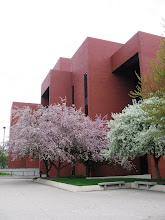Intellectual Property Issues in Higher Education: Faculty Academic Ownership
The basic, bottom line rule in the U.S. Copyright Law is that the person who creates an original work is the owner of the work. With ownership come rights guaranteed by law. For example, our U.S. Copyright law gives both immediate and automatic protection for any original work, including text, audio/visual materials, photographs, web pages, podcasts, vodcasts, music, lyrics, art works, and other types of creative works. The law even covers an original boat hull design.
There are two requirements for this automatic copyright protection:
1. The work has to be an original work of authorship
2. The creation has to be fixed in a tangible medium
Copyright Law provides automatic protection to these works, even without the use of a copyright notice, i.e., ©. Further, the work does not need to be registered with the U.S. Copyright Office. However, an advantage to having a work officially registered is a larger sum for infringement and having your attorney’s fees reimbursed if you win in court.
Classroom educators who provide face-to-face instruction and distance educators are involved in creating new works for their courses and/or their scholarly work. These typically include syllabi, course descriptions, course notes, online course enhancements, and all of the other various works that faculty create to meet instructional objectives and learning outcomes. Published articles and books are owned by the faculty member producing them as well.
Distance educators typically have multiple contributions made in their online classes by college or university support staff such as instructional designers, graphic specialists, technical personnel and the like. The completed distance education course then might be a collaborative effort with multiple claims on content in the same course; in other words, joint authorship may be involved. However, another doctrine in the Copyright Law might be in play with distance education courses, e.g., work-for-hire.
Joint ownership might be obviated by the work-for-hire doctrine for the non-teaching aspects of the course if the contribution to the distance education course was made as part of the contributor’s employment. If that is the case, then the university might be a joint author. In this case, joint authorship may be resolved by an agreement – or assignment – between the instructor and the university. This written agreement between the distance ed instructor and their institution should be made detailing how the instructor and the university can use the work. For example, these uses might include how the university can use the course if the instructor obtains employment elsewhere and whether or not a derivative work of the course can be made. A derivative work is one that is recast, transformed, or adapted from the original, including such modifications as making editorial revisions, condensing it, adding to it, or translating it, among others.
This article only covers a small part of faculty academic ownership of intellectual property. Ownership issues are usually important for the faculty creating new works and also for the dynamic life of the university itself.
For additional information or to have your questions answered, please contact The Copyright and Intellectual Property Office, FDolak@bsu.edu, (765) 285-8032.
Labels: academic libraries, Ball State, copyright law, faculty ownership, intellectuall property, newsletter


0 Comments:
Post a Comment
<< Home